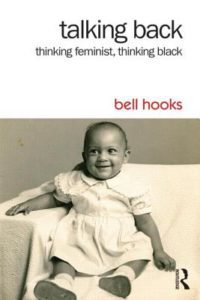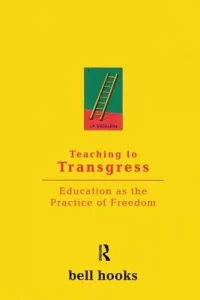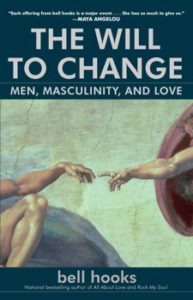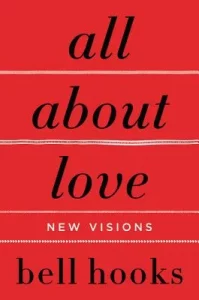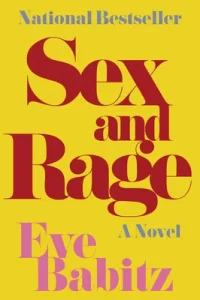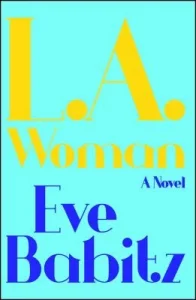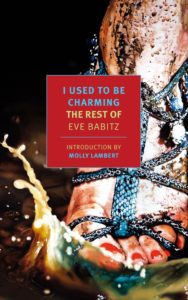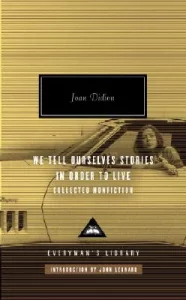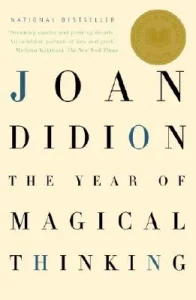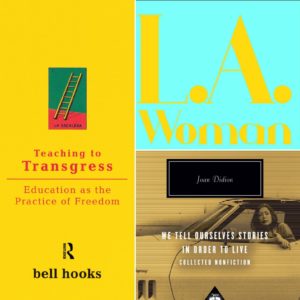
The week of December 15 found the world just a little bit dimmer; within the span of seven days, bell hooks, Eve Babitz, and Joan Didion each passed away. And while they will no longer be sending new work into the world, it’s our belief at The Rumpus that light begets light and so we’ve compiled a short list of texts you might consider reading to honor these women and their distinct legacies.
***
bell hooks
I first read bell hooks in a composition pedagogy class in college, and every few years I reread Teaching to Transgress. I hate to feel as though I am laying any sort of claim on an influential person once they’ve passed, but I do think this book changed my life. I once wrote her a letter inviting her to come speak at a graduate conference in Indiana, and though she politely declined the fact that she responded at all kept me buoyed through an entire winter of graduate school. She was a prolific and a profound writer, and while I will not list all of her books here, I am tempted.
Talking Back: Thinking Feminist, Thinking Black, 1989
In childhood, bell hooks was taught that “talking back” meant speaking as an equal to an authority figure and daring to disagree and/or have an opinion. In this collection of personal and theoretical essays, hooks reflects on her signature issues of racism and feminism, politics and pedagogy. Among her discoveries is that moving from silence into speech is for the oppressed, the colonized, the exploited, and those who stand and struggle side by side, a gesture of defiance that heals, making new life and new growth possible.
Teaching to Transgress: Education as the Practice of Freedom, 1994
Teaching students to “transgress” against racial, sexual, and class boundaries in order to achieve the gift of freedom is, for hooks, the teacher’s most important goal. bell hooks speaks to the heart of education today: how can we rethink teaching practices in the age of multiculturalism? What do we do about teachers who do not want to teach, and students who do not want to learn? How should we deal with racism and sexism in the classroom? Full of passion and politics, Teaching to Transgress combines a practical knowledge of the classroom with a deeply felt connection to the world of emotions and feelings. This is the rare book about teachers and students that dares to raise questions about eros and rage, grief and reconciliation, and the future of teaching itself.
Everyone needs to love and be loved—even men. But to know love, men must be able to look at the ways that patriarchal culture keeps them from knowing themselves, from being in touch with their feelings, from loving. In The Will to Change, bell hooks gets to the heart of the matter and shows men how to express the emotions that are a fundamental part of who they are—whatever their age, marital status, ethnicity, or sexual orientation. But toxic masculinity punishes those fundamental emotions, and it’s so deeply ingrained in our society that it’s hard for men to not comply—but hooks wants to help change that. With trademark candor and fierce intelligence, hooks addresses the most common concerns of men, such as fear of intimacy and loss of their patriarchal place in society, in new and challenging ways. She believes men can find the way to spiritual unity by getting back in touch with the emotionally open part of themselves—and lay claim to the rich and rewarding inner lives that have historically been the exclusive province of women. A brave and astonishing work, The Will to Change is designed to help men reclaim the best part of themselves.
All About Love, 2018
“The word ‘love’ is most often defined as a noun, yet we would all love better if we used it as a verb,” writes bell hooks as she comes out fighting and on fire in All About Love. Here, at her most provocative and intensely personal, renowned scholar, cultural critic and feminist bell hooks offers a proactive new ethic for a society bereft with lovelessness–not the lack of romance, but the lack of care, compassion, and unity. People are divided, she declares, by society’s failure to provide a model for learning to love. As bell hooks uses her incisive mind to explore the question “What is love?” her answers strike at both the mind and heart. Razing the cultural paradigm that the ideal love is infused with sex and desire, she provides a new path to love that is sacred, redemptive, and healing for individuals and for a nation. The Utne Reader declared bell hooks one of the “100 Visionaries Who Can Change Your Life.” All About Love is a powerful, timely affirmation of just how profoundly her revelations can change hearts and minds for the better.
Eve Babitz
I’m going to admit here that I had never heard of Eve Babitz (or read her word) before her recent passing. I wish this surprised me—I loved The Doors in high school—but it does not. I’ve got some catching up to do, and below are my top three to-reads from her bibliography.
Sex and Rage, 1979
We first meet Jacaranda in Los Angeles. She’s a beach bum, a part-time painter of surfboards, sun-kissed and beautiful. Jacaranda has an on-again, off-again relationship with a married man and glitters among the city’s pretty creatures, blithely drinking White Ladies with any number of tycoons, unattached and unworried in the pleasurable mania of California. Yet she lacks a purpose–so at twenty-eight, jobless, she moves to New York to start a new life and career, eager to make it big in the world of New York City. Sex and Rage delights in its sensuous, dreamlike narrative and its spontaneous embrace of fate, and work, and of certain meetings and chances. Jacaranda moves beyond the tango of sex and rage into the open challenge of a defined and more fulfilling expressive life.
LA Woman, 1982
L.A. Woman is quintessential Babitz, the story of Sophie, a twenty-something blonde Jim Morrison groupie gliding through a golden existence in L.A. and Lola, a German immigrant who settles in Hollywood in the twenties to drive Pierce Arrows recklessly down Sunset Boulevard and who knows that Maybelline mascara cakes and Rudolph Valentino are the essence of life. Sophie and Lola, like the many other women who move in and out of this electric saga know that while L.A. is constantly changing it is essentially eternal; through their eyes we see the mixture of high culture and low, the promises of youth and the fulfillment of nostalgia, the pink sunsets and the palm trees that are L.A. And through this fantastic tale, Babitz shares what it is to be a woman in what she convinces us is the capital of civilization.
I Used to be Charming, 2019
With Eve’s Hollywood Eve Babitz lit up the scene in 1974. The books that followed, among them Slow Days, Fast Company and Sex and Rage, have seduced generations of readers with their unfailing wit and impossible glamour. What is less well known is that Babitz was a working journalist for the better part of three decades, writing for the likes of Rolling Stone, Vogue, and Esquire, as well as for off-the-beaten-path periodicals like Wet: The Magazine of Gourmet Bathing and Francis Ford Coppola’s short-lived City. Whether profiling Hollywood darlings, getting to the bottom of health crazes like yoga and acupuncture, remembering friends and lovers from her days hobnobbing with rock stars at the Troubadour and art stars at the Ferus Gallery, or writing about her beloved, misunderstood hometown, Los Angeles, Babitz approaches every assignment with an energy and verve that is all her own. I Used to Be Charming gathers nearly fifty pieces written between 1975 and 1997, including the full text of Babitz’s wry book-length investigation into the pioneering lifestyle brand Fiorucci. The title essay, published here for the first time, recounts the accident that came close to killing her in 1996; it reveals an uncharacteristically vulnerable yet never less than utterly charming Babitz.
Joan Didion
Oh, Joan. Zadie Smith’s bit in The New Yorker is perfect. Dear reader, just do yourself a solid and just buy Didion’s collected works. My partner and I are currently on a road trip across New England, and they don’t know it yet, but we’re going to be listening to The Year of Magical Thinking as soon as we finish our current Agatha Christie novel.
We Tell Ourselves Stories in Order to Live, 2006
Joan Didion’s incomparable and distinctive essays and journalism are admired for their acute, incisive observations and their spare, elegant style. Now the seven books of nonfiction that appeared between 1968 and 2003 have been brought together into one thrilling collection. Slouching Towards Bethlehem captures the counterculture of the sixties, its mood and lifestyle, as symbolized by California, Joan Baez, Haight-Ashbury. The White Album covers the revolutionary politics and the “contemporary wasteland” of the late sixties and early seventies, in pieces on the Manson family, the Black Panthers, and Hollywood. Salvador is a riveting look at the social and political landscape of civil war. Miami exposes the secret role this largely Latin city played in the Cold War, from the Bay of Pigs through Watergate. In After Henry Didion reports on the Reagans, Patty Hearst, and the Central Park jogger case. The eight essays in Political Fictions—on censorship in the media, Gingrich, Clinton, Starr, and “compassionate conservatism,” among others—show us how we got to the political scene of today. And in Where I Was From Didion shows that California was never the land of the golden dream.
The Year of Magical Thinking, 2007
Several days before Christmas 2003, John Gregory Dunne and Joan Didion saw their only daughter, Quintana, fall ill with what seemed at first flu, then pneumonia, then complete septic shock. She was put into an induced coma and placed on life support. Days later–the night before New Year’s Eve–the Dunnes were just sitting down to dinner after visiting the hospital when John Gregory Dunne suffered a massive and fatal coronary. In a second, this close, symbiotic partnership of forty years was over. Four weeks later, their daughter pulled through. Two months after that, arriving at LAX, she collapsed and underwent six hours of brain surgery at UCLA Medical Center to relieve a massive hematoma. This powerful book is Didion’s attempt to make sense of the “weeks and then months that cut loose any fixed idea I ever had about death, about illness … about marriage and children and memory … about the shallowness of sanity, about life itself.

